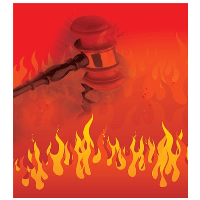California Regains Top Spot on Conservative List of “Judicial Hellholes”

Could there be a prouder place for an environmentally conscious, socially responsible state that puts the health and safety of its residents ahead of corporate profits than atop the American Tort Reform Foundation’s (ATRF) annual list of “Judicial Hellholes”?
Take a bow California. Right-wing sound machines hate you.
Two years ago, before Madison County, Illinois, knocked California off its perch, Daniel Fisher at Forbes summed up what it took to claim first place. “The Golden State won for the welcoming stance its courts take toward consumer class actions—particularly against food companies—and rampant lawsuits targeting small businesses over disability-access rules.”
But the comeback kids had to come up with something special to reclaim the crown and Fisher ID’d it: “A logic-stretching ruling by a California judge holding manufacturers of lead paint and pigment liable for the $1.2 billion cost of renovating hundreds of thousands of homes.”
That ruling, in December 2013 by Santa Clara County Superior Court Judge James Kleinberg, was sympathetic to a novel legal argument that lead paint manufacturers violated public nuisance laws, rather than health laws, by poisoning children who live in pre-1978 housing with products they knew were dangerous.
Government lawyers argued they didn’t have to show that specific individuals were harmed in a direct way, only that the industry assisted in the creation of a public nuisance. By “renovating” homes, Fisher meant that NL Industries, ConAgra and Sherwin Williams had to pay into a fund administered by the state’s Childhood Lead Poisoning Prevention Branch to cover inspections and lead abatement.
Exposure to lead can cause permanent brain damage and about half a million American children are said to be suffering from it. Lead lowers IQs, causes learning disabilities and has been linked to criminal behavior. It has also been linked to stunted growth, seizures and a range of maladies.
The foundation did not rely solely on California’s accomplishments in the area of lead abatement in reaching its decision. “California is the epicenter for lawyers trolling to bring disability access lawsuits against small businesses and ridiculous class action lawsuits against food and beverage companies,” the report said. “Certain areas of the state are also a hotbed for asbestos litigation.”
Food and beverage lawsuits often challenge mislabeled products. Really, who is to say what is “natural”? And do people really need to know when they are consuming a GMO product or what’s in the supplement they take? A lot of states don’t care.
California does, thus permitting more lawsuits to be filed. That puts more stress on an already-stressed legal system and creates what the foundation deems “judicial hellholes,” where only well-connected trial lawyers prosper under the protection of Democratic politicians.
The report does not attempt to analyze in any systemic statistical fashion the effect of California laws on business in the state. Rather, it’s just a gathering of random information from American Tort Reform Association (ATRA) “members and other firsthand sources. . . . ATRA also continually receives tips and additional information, which are then researched independently.”
Eric Bailey, communications director for Consumer Attorneys of California (CAOC), did not think much of the methodology. He told Legal Newsline, “The tort war mouthpiece for the oil, tobacco and insurance industries is engaging in more silly season spin with its annual pseudo-study, which is nothing but distortions and propaganda from a few fading embers off the Fortune 500 list.”
Bailey made a spirited defense of the California legal system and business climate:
“Our civil courts protect little kids from the lingering threat of lead paint and ensure justice for victims of asbestos poisoning. They provide a forum for folks injured by defective products or threatened by environmental degradation. They also allow businesses a way to resolve disputes over intellectual property and other matters that pit business versus business, which today is California’s fastest growing type of litigation. If that sort of high-functioning civil society is mischaracterized as a hellhole, give me a bag of marshmallows.”
It was on the strength of its asbestos litigation alone that New York City grabbed the #2 spot on the Hellholes list. It was followed by Missouri; Madison County; Louisiana; Hidalgo County, Texas; Newport News, Virginia; U.S. District Court for the Eastern District of Texas; West Virginia; Philadelphia; New Jersey; and Pottawatomie County, Oklahoma.
–Ken Broder
To Learn More:
Lead-Paint Ruling Helps Push California to Top of U.S. "Judicial Hellholes" List (by Daniel Fisher, Forbes)
California Tops List of “Judicial Hellholes” by Tort Reform Group (by Jessica Karmasek, Legal Newsline)
Forbes Hypes Still-Ridiculous “Judicial Hellholes” Report (by Meagan Hatcher-Mays, Media Matters)
Food & Beverage Cases to Watch in 2015 (by Andrew Westney, Law360)
Judge Orders Companies to Pay $1.1 Billion in 13-Year-Old Lead-Paint Lawsuit (by Ken Broder, AllGov California)
2015-2016 Judicial Hellholes (American Tort Reform Foundation) (pdf)
- Top Stories
- Controversies
- Where is the Money Going?
- California and the Nation
- Appointments and Resignations
- Unusual News
- Latest News
- California Forbids U.S. Immigration Agents from Pretending to be Police
- California Lawmakers Urged to Strip “Self-Dealing” Tax Board of Its Duties
- Big Oil’s Grip on California
- Santa Cruz Police See Homeland Security Betrayal in Use of Gang Roundup as Cover for Immigration Raid
- Oil Companies Face Deadline to Stop Polluting California Groundwater





